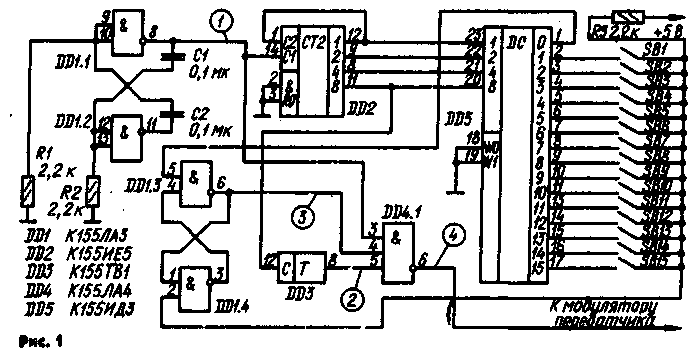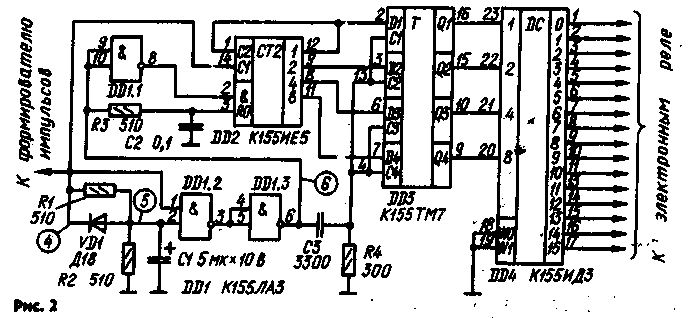
|
|
ENCYCLOPEDIA OF RADIO ELECTRONICS AND ELECTRICAL ENGINEERING Encoder and decoder of telecontrol commands. Encyclopedia of radio electronics and electrical engineering
Encyclopedia of radio electronics and electrical engineering / Radio control equipment The advantages of digital systems for encoding and decoding commands in remote control equipment for models have already been noted in the literature. Another version of the encoder-decoder complex for 15 discrete commands, designed for the same purpose, is described below. The scheme of the encoder is shown in fig. 1, and the decoder - in Fig. 2. The waveform at some characteristic points of the device is shown in fig. 3. At the output of the command encoder, there are bursts of pulses of negative polarity (graph 4 in Fig. 3). The repetition rate of bursts of pulses is f / 32, where f is the frequency of the master oscillator, made on the logic elements DD1.1.DD1.2 (Fig. I) according to the symmetrical multivibrator circuit. From the master oscillator, the pulses (graph 1) are fed to the counter DD2 and to the element of coincidence .DD4.1. Pulses with frequency f will pass through this element when triggers DD3 and DD1.3.DD1.4 are in a single state (graphs 2 and 3). Counting trigger DD3 switches after every 16th pulse received at the counter DD2. The free inputs of the DD3 trigger are combined and connected through a 1 kΩ resistor to the positive output of the power source. RS-trigger DD1.3.DD1.4 is set to the single state by the zero signal level at output 0 (pin 1) of the decoder DD5 and to the zero state by the zero signal level at that of the decoder outputs, which is connected to pin 2 of the DD1.4 element. 1 through the contacts of one of the buttons SB 15-SB XNUMX. The number of impulses in a pack is equal to the number of the pressed button. If none of the buttons is pressed, then the encoder generates bursts of 16 pulses, since the RS-trigger DD1.3.DD1.4 is not transferred to the zero state. The command decoder is assembled on four microcircuits (Fig. 2). A node assembled on the elements DD1.2.DD1.3. is a pulse selector. During the time between two pulses of negative polarity with a frequency f, the capacitor C1 does not have time to charge up to a voltage sufficient to transfer the element DD1.2 to the zero state, and the signal level corresponding to logic 1.3 remains at the output of the element DD0. During the same the time interval between bursts of pulses, the capacitor C1 is charged to a unit voltage at pin 2 of the DD1.2 element (graph 5) and a signal 1.3 appears at the output of the DD1 element (graph 6). Diode VD1 provides fast discharge of capacitor C1. By the decay of the pulses from the output of the element DD1.3, the counter DD2 is set to zero, and from their fronts, the differentiating circuit C3.R4 generates pulses for writing information from the counter DD2 to the storage node on the trigger DD3. With one pulse in the pack, the counter DD2 remains in the zero state, with two it goes to state 1, with three it goes to state 2, etc. Actuators are connected to the outputs of the decoder DD4 through an intermediate link - an electronic relay. The circuit of the electronic relay is shown in fig. 4. The first electronic relay is connected to output 0 (pin 1) of the DD4 decoder, the second to output 1, etc. The sixteenth relay, connected to pin 17, is on when none of the buttons is pressed in the encoder. With this construction of the receiver, only one actuating device can be switched on at the same time. It turns on for the time the button is pressed in the command encoder in the transmitter. For independent switching on and off of actuators, independently between the decoder and each electronic relay, it is necessary to turn on the RS-trigger according to the diagram in Fig. 5. Trigger inputs are connected to two adjacent decoder outputs; for example, the inputs S and R of the first trigger are connected to outputs 0 and 1 of the decoder, respectively, the second to outputs 2 and 3, the third to outputs 4 and 5, etc. The number of actuators is halved. Capacitor C1 is required to set the RS flip-flop to a single state when the power is turned on. When the output of the RS flip-flop is high, relay K1 is de-energized. If for some time a 0 signal is applied to input R, the trigger will be set to zero and relay K1 will turn on. The relay will turn off when a zero signal level is applied for some time to input S. Thus, a command on one of the channels turns on the relay, and on the next one it turns it off. If necessary, a part of the electronic relays can be switched on according to the scheme of fig. 4, and the rest - with an RS flip-flop. Relay K1 - RES15, passport RS4.591.003. When checking the operability of the device, the output of the command encoder is connected to the input of the decoder. The frequency of the master oscillator can be chosen differently, you just need to select the capacitor C1 in the command decoder (at a higher frequency, the capacitance of the capacitor should be smaller). There are no high requirements for the frequency stability of the master oscillator. Author: V. Inozevtsev, Bryansk; Publication: N. Bolshakov, rf.atnn.ru
Artificial leather for touch emulation
15.04.2024 Petgugu Global cat litter
15.04.2024 The attractiveness of caring men
14.04.2024
▪ TRACO TPI small economical power supplies ▪ Creation of strong magnetic fields by a pulse of laser light ▪ Battery powered by human saliva ▪ The brain turns words into pictures
▪ section of the site Security and safety. Article selection ▪ article I was married without me. Popular expression ▪ Where did the word school come from? Detailed answer ▪ Article Civil radio communications. transmitters. Directory
Home page | Library | Articles | Website map | Site Reviews www.diagram.com.ua |






 Arabic
Arabic Bengali
Bengali Chinese
Chinese English
English French
French German
German Hebrew
Hebrew Hindi
Hindi Italian
Italian Japanese
Japanese Korean
Korean Malay
Malay Polish
Polish Portuguese
Portuguese Spanish
Spanish Turkish
Turkish Ukrainian
Ukrainian Vietnamese
Vietnamese



 Leave your comment on this article:
Leave your comment on this article: